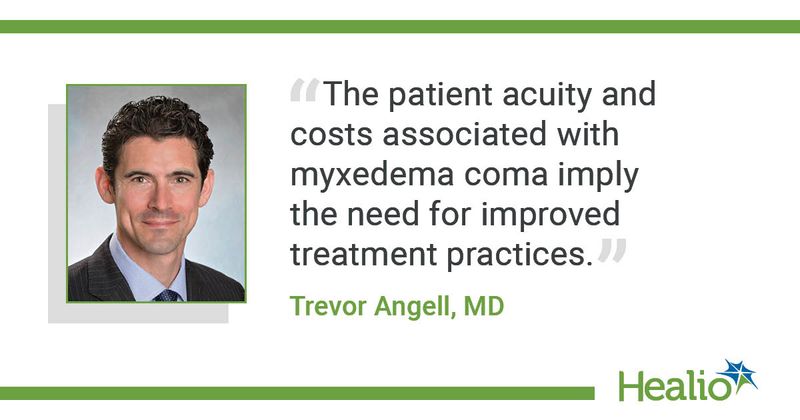Adults diagnosed with myxedema coma have increased mortality risk, longer hospital stay
Key takeaways:
- Adults with hypothyroidism diagnosed with myxedema coma have a higher mortality rate than those without myxedema coma.
- Myxedema coma is also associated with a longer hospital stay and higher health care costs.
SEATTLE — Hospitalized adults with hypothyroidism who are diagnosed with myxedema coma have a higher mortality rate and are hospitalized for longer than those without myxedema coma, according to a speaker.
“Although decompensated hypothyroidism, often called myxedema coma, is recognized as an emergent condition with high mortality, its rarity prevents robust analysis of its characteristics and implications,” Trevor Angell, MD, associate medical director of the Thyroid Center and assistant professor of clinical medicine in the division of endocrinology, diabetes and metabolism at the Keck School of Medicine, University of Southern California, told Healio. “In this study, we used national data from U.S. hospitals from 2016 to 2018 to investigate cases coded as myxedema coma compared to other admissions for hypothyroidism. Our data show that myxedema coma is associated with not only high mortality, but also increased length of hospital stay and hospital costs, which is likely related to associations we observed between myxedema coma and multiorgan failure and more advanced care needs, such as vasopressors and hemodialysis.”

Angell and colleagues conducted a retrospective analysis of inpatient hospital admissions to non-federal hospitals in the U.S. from 2016 to 2018. Adults aged 18 years and older with a primary diagnosis of hypothyroidism or myxedema coma were included. Demographics, mortality, length of hospitalization and costs were obtained from the National Inpatient Sample database.
The findings were presented at the AACE Annual Scientific and Clinical Conference.
There were 18,635 adults with hypothyroidism included in the study, of whom 13.4% were diagnosed with myxedema coma. Older adults, those with public health insurance and unhoused adults were more likely to be diagnosed with myxedema coma. Adults who had previously been diagnosed with septicemia, acute myocardial infarction or adrenal insufficiency all had a higher risk for being diagnosed with myxedema coma. Adults diagnosed with myxedema coma were more likely to use a vasopressor or experience cardiogenic shock, acute heart failure or acute respiratory failure than those not diagnosed with myxedema coma (P < .001 for all).
During the study period, the annual mortality rate for adults with myxedema coma ranged from 5.1% to 9.3%, whereas adults with hypothyroidism but without myxedema coma had a mortality rate of 0.5% to 0.9%. While there was a higher mortality rate among adults with myxedema coma, Angell said, the rate was lower than what was observed in prior studies.
“One hypothesis is that our data, covering a more contemporary period, reflects improved recognition of decompensated hypothyroidism, use of intravenous levothyroxine therapy or advances in hospital care generally,” Angell said.
The mean length of hospitalization was 8.28 to 10.4 days for adults with myxedema coma and 4.36 to 4.86 days for adults without myxedema coma. Mean hospitalization costs were more than twice as high for adults with myxedema coma, ranging from $86,511 to $92,415. Adults with hypothyroidism and without myxedema coma had mean hospitalization costs of $34,025 to $42,730.
“The patient acuity and costs associated with myxedema coma imply the need for improved treatment practices or preventive care to avoid this,” Angell said. “These data demonstrated that admissions coded for myxedema coma were more common for older patients and those without private insurance, suggesting also some possible health care disparities between populations.”
Angell said future studies analyzing patient-level clinical data are needed to better optimize the diagnosis and treatment of myxedema coma.
“Because of the rarity of this condition, obtaining sufficient robust samples from individual institutions is challenging,” Angell said. “Ideally, future efforts can form multicenter consortiums to aggregate data and create a more robust and generalizable understanding of this condition.”

